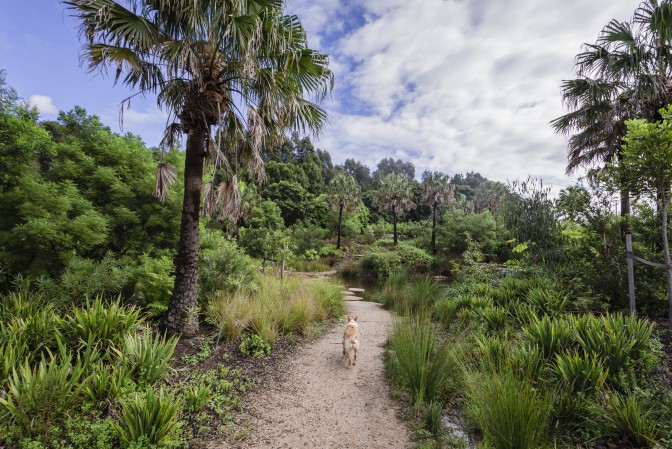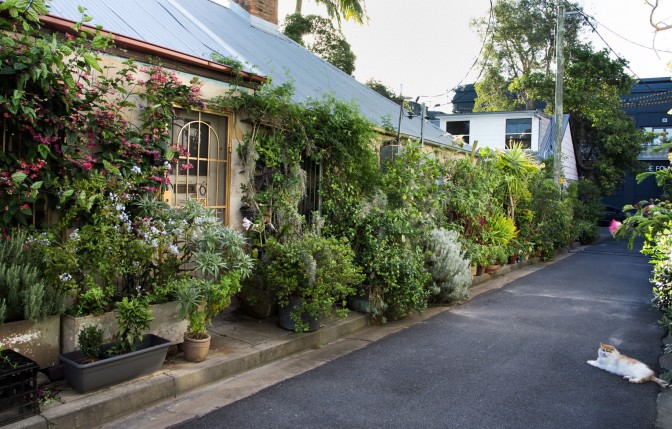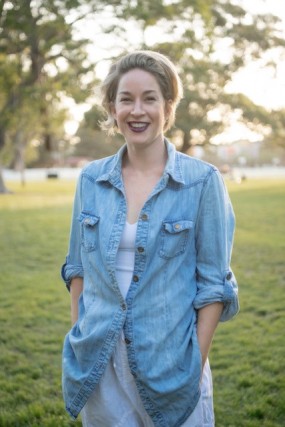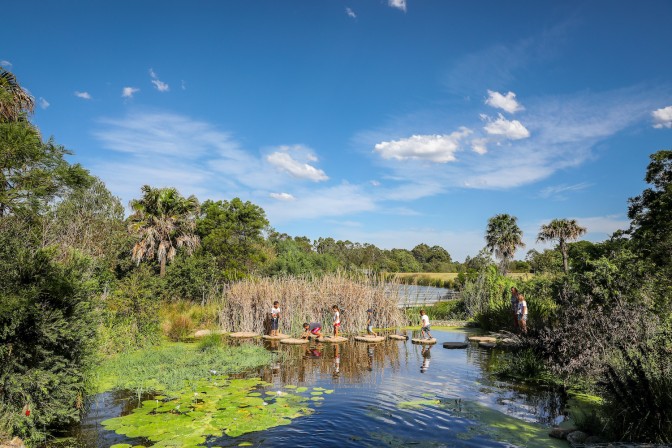Re-Greening and De-Paving Sydney
Jess Miller, Councillor, City of Sydney
Sydney Park. Photo by Jacquie Manning.
The following is transcribed from an excerpt of the Facebook Live broadcast, Costa’s Live Edible Garden Odyssey: Growing Food in Urban Spaces. The full video recording can be watched here. Minor edits have been made for clarity.
Costa Georgiadis: There are a lot of great things happening in urban agriculture, but we also need to confront all its challenges, so that people hitting walls can do something about it. One person that has done something about it is Councillor Jess Miller. She put herself on the line and said, “I'm not going to be frustrated and sit in the corner, I'm going to stand up and become a representative.” And she was the youngest ever person to be elected a councillor in the City of Sydney.
Jess, you've had a very strong drive behind you in terms of greening our cities. From the time that you've been on council you've been so proactive. Tell us about the verge gardening and the greening of cities and how urban agriculture is unfolding in Sydney.
Councillor Jess Miller: It's difficult to sometimes know whether you would be more effective working from the outside in or the inside out. Now being on the inside,, I think it’s really interesting because you start to understand not only what the challenges are in more detail, but also what the solutions can be.
What I’ve come to understand is when you're in hyper-dense urban environments like the City of Sydney, where we have got all of these competing needs, you have to be quite strategic with how you approach certain issues. The big key that I've discovered that blocks the solutions, and also causes all the barriers, is actually planning. You often come to these junctures or sticky points where you’ve got a group of people whose job it is to look at a piece of paper and say, “These are rules and this is what this land can and should be used for.” Then you've also got people like me who really frustrate them and say, “Come on, can’t we do better?” So it's a constant conversation but one that I think is really worthwhile having.
One of the most exciting things that's happened to me in the last week has been working with our local Member for Sydney, Alex Greenwich, to put this idea of a food security plan for Metropolitan Sydney on the table. Pre-COVID, there were 17,000 people who were food insecure in the City of Sydney, and when you look around you look at these skyscrapers and buildings and you go, “This isn't a place where you can grow food.” But it's got to be part of the food system, because we in the city are so connected to the suburbs, to the farms in the regions, to the land further out. So having this framework, and also signing the City of Sydney up to the Milan Urban Food Policy Pact has been a couple of big wins that have happened quite recently that I’m pretty happy about.

Cat Alley Gardens. Photo by The Design Files, used with permission from the City of Sydney.
CG: Has your work within local government given you that perspective of patience? How do you manage the frustration?
JM: You’ve just got to keep chipping away at it. I grew up on a herb farm down in the Mornington Peninsula, so growing things is just in my DNA. When I first moved to Sydney I was quite lonely, I didn't know anyone, and being part of Permablitz with Friends of the Earth was a way to be able to connect with other people. I think that when you garden and do things like Permablitz, you get this feeling of transformation that comes when you take a space that isn’t alive and you turn it into something beautiful. It's really empowering.
Trying to promote and embed this idea of cities as regenerative places is something that we're hearing a lot from the community. It's something we're really championing as we move forward in the City of Sydney, so that cities are not places that are ‘parasitic’ and just take and extract from natural systems; we need to re-imagine cities as places that also support and give back to these systems.
The water just can't just run off into the sewer, it has to stay in the ground, it has to provide sustenance for our tall trees, it has to cool our cities; the rooftops have got to be contributing to pollinators; we're losing more green space in our backyards than ever before, so how can we compensate that by reclaiming our laneways and our public spaces and our verges? These are all very big ideas, and every time you try and push it, you do come up against a no. So I've just found that you need to throw everything at it—everything—all the time.

Councillor Jess Miller. Photo by Nic Walker.
CG: In that space where you’re constantly working, one of the things that can kick in, particularly for volunteers working at that community level, is personal fatigue. How do you protect your energy so that you don’t get drained? How do you personally maintain your energy level when you do hit walls so as not to fall down and give up?
JM: Gardening in nature is something that has always given me a lot of energy. Being in nature and keeping my bees and having a tiny little spot in the city and filling it full of flowers is just a constant source of energy. I've two hives now, too, so whenever I feel a bit sad I go and check out what the girls are doing—that’s been a great source of energy. But I think it's really about working with other people. When you're part of a group and part of a community, you really do feed off one another. I also like to throw as much out there as possible, so that if one thing isn't working, I haven't just got a Plan A, there's also a Plan B, C, and D. There's also a lot of fabulous things happening in the city. We have some of the most brilliant, innovative, thoughtful, and creative community members that you can imagine. So I never feel alone or frustrated. I feel like I'm part of a community, part of a movement. I think COVID has been such an interesting reframe of his opportunity, because everyone is identifying and connecting with the importance of food systems and local economies, and valuing their public and green spaces more than ever. So I'm not sad about it, ever.
CG: Everything you explained just then is totally connected with regenerative thinking. That regenerative thinking is coming around—it’s not just a parallel universe now, it’s on the radar. Ten years ago, regenerative agriculture was beyond a parallel universe, it was a meteorite flying in another universe. But now people are talking about it. Even commercial radio is talking about buying local and supporting your local businesses. How important is that language in the work that you do?
JM: The language is important, but what we're offering people is so valuable. I think that the thing we have in our favour is experiential marketing, this concept that they use in advertising. What an advantage that we have: There's no better way to persuade somebody of the benefit of the living, regenerative city than to take them down a laneway where you've got the scent of jasmine in the air, you've got kids knocking into each other, you’ve got flowers, you’ve got veggies. In a way, it kind of sells itself.
Also, what I find quite valuable is that sometimes you get to change up the language depending on who you talk to. Often when I come up against a barrier, I might shift the conversation from these preconceived notions of community gardening and say, “Yeah, but think about the social resilience that we're building in our cities. Cities can be very lonely, alienating places. Just imagine if, instead of at the bottom of a big apartment building where you have the Thai massage joint, the dry cleaner, the 7-11, the fish and chip shop, imagine if instead we were to open those small spaces into something where people could gather?
What if we had community gardening clubs at the bottom of every building, where there was a potting bench, a composting place, a little nursery for your seedlings? Imagine how much better people would feel, not only connecting with their neighbours but also overcoming the pragmatic challenge of lugging 20kg of soil up to their 40th floor apartment to repot their house plants!
This kind of idea also overcomes the issue of equity that is creeping into our cities. Community gardens are fantastic, but I think that given the competition for space in cities and the deep need we have to connect, we need to be open to adapting the old school ‘plot model’ which limits participation to other ways of designing and operating these spaces.
There are endless possibilities, but I think I'm learning that if I want that vision to come to life, I have to then speak the language or planning. I have to talk about changes to the local environment plan. That's something that I think I'm trying to add to my tool belt of skills and trying to be a bit more persuasive about.

Sydney Park.
CG: That is a really wonderful example or focus. As you said, there’s an element of scattergun, because you bring a wide blanket with you so that if someone doesn't see eye to eye with one idea, you've got 75 others. But at the same time that blanket is pointed at that Achilles heel: Not just hitting the same old banner and marching, but going to the planners. That’s where the real long-term foundation gets its base to go and generate those 75 other ideas.
JM: There’s this beautiful work—I mean, Bruce Pascoe has been so seminal in thinking about indigenous grasses—but I was at a talk recently called Dhuwarr: bread - A celebration of Gomeroi grasses, grains and placemaking. There was a panel discussion looking at the broad benefits of native grasses. My little brain is ticking over and going, “Hmm this is interesting.” Because we have these native grasses that are really context specific, and I suppose I'm going, “Well one of the big no’s I always hear about urban ag is that the maintenance costs are very expensive for councils and we don't have an endless fund of resourcing.” But I'm sitting there going, what if we were able to switch out normal grass for native grasses and tell a story and invite that conversation around the green and ochre grid and the Euro journey into our parks? How can we make them work harder, but also work in a more elegant and systemic way?
We should be able to get all the co-benefits and make these places really special from an indigenous perspective, the social cohesion perspective, and the environmental and food security perspectives. People have to remember that they are intrinsically part of urban ecology. It doesn't exist without us and we are the beneficiaries, but also we have a huge responsibility to ensure that we are replenishing the places that we inhabit.
CG: To hear this level of focus, you're really providing a pathway to action across so many levels. All of this is about how these public spaces craft the future of our culture. These are corridors, they’re arteries of connection, not just in terms of pollinators and birds, but arteries of community connection.What would you say to people who are struggling a little, maybe they're coming up against the wall with their council. What would your parting words be in terms of your take on this?
JM: I would say just do it. I was part of a group way before I was in council, and we decided that this is public space and we want to garden it. The garden was pulled out for a whole bunch of reasons (many of which were fair enough), but you can't be discouraged by that. You’ve got to keep pushing.
It's up to all of us to take responsibility to water the verges, to put in the plants. If you wait around for councils and governments to do it for you, you're going to be waiting forever.
It’s also really important to organise well - whatever you create has to be well-managed, well-loved, open to the community and well cared for. Pick your elected representative carefully, engage with them, show them what’s possible. You will hear no’s. We've got a really hard example at the moment where we constantly have to weigh affordable housing versus space. So there are competing priorities. Don’t just go there, do it, show them what's possible. Use your imagination, use your community, collaborate.
Always look for those opportunities that can be scaled and replicated, and be very generous with what you learn along the way, because that's what's going to create change in the long term.
________________________________________________________________________________________
All photos provided by the City of Syndey.
Councillor Jess Miller was elected to the City of Sydney Council as part of the Clover Moore Independent team in 2016. Part of her motivation for being on Council was to ensure that views of younger people were represented on Council (especially with regard to the 24-hour economy) and that the City continue set a global example of how to deal with the changing climate. Jess’ key areas of expertise are in environmental systems, specifically urban ecology and urban forestry, and local food systems. She is an advocate for a slow city with lots of active and public transport, character, community, sport, colour and creativity.